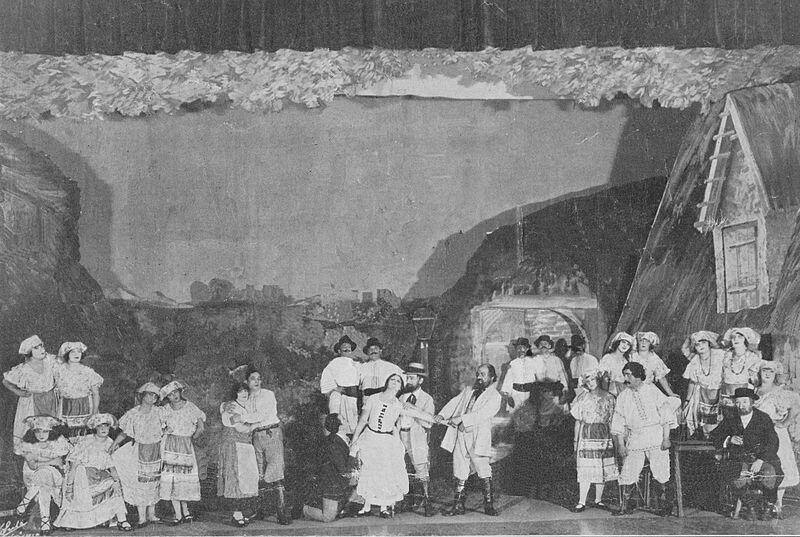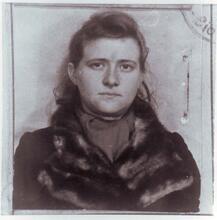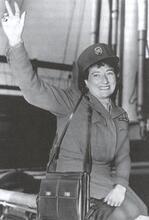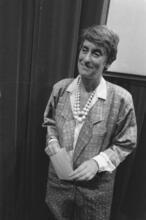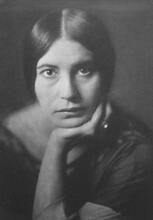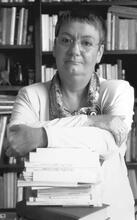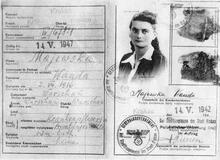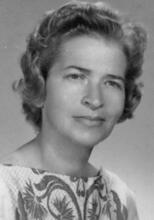Romanian Yiddish Theater
Yiddish theater in Romania was a cultural cornerstone for Eastern European Jews for over a century. The onset of Yiddish theater in Romania came with modernization in the late nineteenth century, and Jewish theater troupes were founded in the major Romanian cities. Many acting troupes traveled throughout the country, performing dramas, comedies, musicals, and operettas. Yiddish theater companies included women in the ranks of the actors, especially in the 1930s and 1940s. Most of the theater troupes and companies included many women who had a significant impact on the scope of activity, the repertoire, and the development of each group. Several Jewish actresses were noteworthy for their successes in the early 1920s and went on to influence Yiddish theater in Israel and worldwide.
Beginnings of Yiddish Theater in Romania
One facet of the rich Jewish cultural scene that developed in Romania in the late nineteenth and early twentieth centuries consisted of theatrical activity in its various forms. Jewish society in Romania, as in most parts of Eastern Europe, experienced a process of modernization at the end of the nineteenth century (albeit considerably later than in Western Europe). This process was marked by a greater openness to general Western education (alongside Jewish training) for the younger generation of both sons and daughters, and a willingness to join in the intellectual and cultural developments taking place around them. These changes were more typical of urban Jewish society, which was by nature more open to the winds of change and less conservative in its adherence to the traditional Jewish cultural frameworks and patterns. Thus, in the late nineteenth century Jewish theater troupes were founded in the major cities of Romania, in particular Bucharest and Jassy. Likewise, theater groups with Jewish actors were established in the major cities of the four provinces annexed to Romania following World War I—among them, Chernovtsy (Czernowitz) in Bukovina and Kishinev in Bessarabia—as well as in the smaller cities and towns. These territories (Transylvania, acquired from Hungary; Bukovina, from the Austro-Hungarian Empire; Bessarabia from the Soviet Union; and Dobruja, from Bulgaria) changed hands among assorted states and powers, each of which in turn instituted various laws and regulations, whether with regard to the permissibility of including Jewish actors in general theater troupes, or of allowing them to operate a separate Yiddish theater. Accordingly, sometimes the prevailing trend among Jewish actors, actresses, playwrights, and directors was to join the ranks of the Romanian theater, whereas at other times the bulk of their activity was confined to the Jewish, and especially the Yiddish, theater.
Romania can in fact be considered one of the wellsprings of the Yiddish theater. This theatrical genre was developed in Eastern Europe in the latter half of the nineteenth century by the poet and playwright Abraham Goldfaden (1840–1908), regarded as the founder of Yiddish theater. The roots of the Yiddish theater actually lie in Zhitomir, where a play by Solomon Ettinger was produced at the rabbinical seminary in 1862 as a Holiday held on the 14th day of the Hebrew month of Adar (on the 15th day in Jerusalem) to commemorate the deliverance of the Jewish people in the Persian empire from a plot to eradicate them.Purim shpil (Yiddish for Purim play), with Goldfaden in the lead role. After continuing on to Lvov and Chernovtsy, Goldfaden met the Yiddish troubadour Israel Grodner of Berl Broder’s traveling Yiddish singing troupe in 1876 in Jassy, where together they founded the first Yiddish theater company. The first newspaper reference to a Jewish theater in Romania was a review by Mihai Eminescu în the Romanian newspaper Curierul de Iași in 1876, in which he described this troupe of sixteen Jewish actors, from tavern singers to cantors, who performed in the wine cellars of Jassy under Goldfaden’s management. In fact, Goldfaden served not only as the troupe’s impresario and manager but also filled the roles of composer, set designer and director, in addition to “discovering” and guiding the actors. In the breadth of its repertoire, the Yiddish theater of Romania, like that of other East European countries, was admittedly “primitive” in certain respects; but as a genre of folk art, particularly in its early stages, it endeared itself to a broad Jewish audience and quickly met with success in its travels through most of the districts of Galicia, Russia and Poland, becoming a permanent fixture of Jewish folk culture in Romania, as in other parts of Eastern Europe.
In 1883 the authorities in Tsarist Russia issued a ban on theater performances in Yiddish and from that year until the prohibition was lifted in 1908 Romania and Poland became the chief centers of Yiddish theater. Five highly successful Yiddish theaters operated continuously in Romania until the start of World War II—two in Bucharest, two in Chernovtsy and the original one in Jassy
Integration of Women in Romanian Jewish Theater
During the early interwar period, owing to the relatively favorable atmosphere in the Romanian cultural arena, the Jewish-Yiddish theater in Romania gave birth to a number of acting troupes that appeared throughout “Greater Romania” and beyond, in assorted plays, dramas, comedies, musicals and operettas. Among the distinctive features of these Yiddish theater companies was the (gradually) increasing openness to the inclusion of women in the ranks of the actors, which reached its peak in the 1930s and 1940s.
Most of the theater troupes and companies included a sizable number of women, who had a significant impact on the scope of activity, the repertoire, and the development of each group. A number of Jewish actresses were noteworthy for their successes in the early 1920s, among them Sarah Kanner, who made frequent appearances with the troupe founded by her husband, the actor Leopold Kanner, performing throughout Romania, in other parts of Europe and even in the United States.
Among the first theater groups to emerge in Greater Romania was that of Moses Siegler. The importance of this group lies not only in the broad range of theatrical works that it presented both in Romania and elsewhere (mainly Austria) but in the large number of women who found their place there as actresses, quickly becoming leading figures in the world of Romanian Jewish theater. These included Dina Feinmann, Malvina Glükmann, Cily Adler, and Sevilla Pastor, one of the three actresses daughters of Moni Pastor. The Pastor sisters became the foremost Jewish actresses in the world of Romanian Jewish theater in the years between the two world wars.
A new feature of the theatrical scene consisted of light pieces performed by small groups appearing in the courtyards of major theaters in various cities. One of the more popular troupes working in this genre in the 1920s was the Trupa Kanapoff, whose members included the actresses Maria Kanapoff, Tina Guhten, Betty Bergher, Ghizela Negreanu, Reghina Simovici and others.
The dynamic cultural activity that was a hallmark of urban Jewish society in Romania served as a magnet for Yiddish theater troupes from other parts of Eastern Europe, among them the Trupa din Vilna (more widely known as Di Vilner Trupe), which was invited to Bucharest in the mid–1920s by theater personality Isidor Goldenberg and met with sweeping success. In its first two years alone (1923–1925) it mounted dozens of performances of the thirty-five plays in its repertoire. This group, too, boasted a considerable number of women performers, some of them highly respected in the world of East European Jewish theater, including Hannah Braz, Lyuba Kadison, Helen Gotlib, Jehudit Lares, Hannah Mogel, Miriam Orleska, and one of the major actresses of Jewish theater in Romania, Dina König.
Another important theater group that operated in the Romanian capital during the 1920s was the Studioul teatrul evreiesc din Bucuresti (BITS), under the direction of Jacob Sternberg, one of the key figures in the development of Jewish theater in Bucharest and in Romania as a whole. Among the women who were active in this troupe, one, in particular, is worthy of special mention: the major actress, Sidy Thal, who was born in 1912 in Chernovtsy with the name Surele Birkenthal. In 1935, following impressive work in a broad range of roles in the Romanian Yiddish theater, Thal became director of a theater group in Bucharest that met with great success on tour throughout Romania, presenting Yiddish plays directed by Jacob Sternberg.
One of the characteristics of Yiddish theater that affected the work of Jewish women from the nineteenth century was the way theater troupes were organized. Most of the Yiddish theater groups were built around a nucleus of several married couples who were actors, who every few months traveled among various cities in the Romania-Galicia region, performing for lovers of Yiddish theater in the Jewish communities. The configuration of this activity explains how women could work in theater in conservative Jewish society at that time and place. The character of this activity, in which many of the children of the actor couples spent a great deal of their time and childhood in the theater, explains how the sons and daughters of actors or theater personnel became successful actors themselves. Indeed, the character of this activity finds expression in the work of actors who were the wives or daughters of well-known actors in most Yiddish theater troupes, such as the Pastor, Kaner and König-Kamen families, and many others.
Jewish Theater in Outlying Communities
In addition to the major urban centers, the theatrical activity took place in Jewish communities in small towns and cities in the various regions of Romania, although differing in quantity and quality from the offerings in the big cities. In most of the towns, and even more so in the villages, there was no building dedicated to theater arts, with the local “community center” serving as the usual venue. Plays and performances in ethnic-German communities in various parts of Bukovina (such as the town of Gura-Humorului), Banat, Transylvania, and Bessarabia were mounted in the local Deutsche Gasthaus or German guesthouse. For the most part, the Jewish communities in these locales were socially rather insular; as a result, they did not play host to as wide a range of acting troupes endeavoring to promote theatrical creativity as did the large cities.
Although wide-scale independent theatrical activity did not develop in the tiny, peripheral Jewish communities, most Jewish towns were magnets for the large Jewish theater troupes from the cities, which in their travels reached most of the towns and small communities, presenting their rich repertoire to lovers of Yiddish theater. Nevertheless, the development of the theater arts in some of the locales, and especially the integration of women in the local small-town theater groups, can be seen as proof of progressive leanings and openness to secular cultural patterns on the part of the highly traditional Jewish society in the small towns of the Romanian provinces. One of many such examples is the town of Edineti in Bessarabia which, like many Jewish communities in the Tsarist Empire, saw the development of drama groups for young people as early as the close of the nineteenth century. As in other rural settings, theatrical expression in those years was generally limited to performances of Holiday held on the 14th day of the Hebrew month of Adar (on the 15th day in Jerusalem) to commemorate the deliverance of the Jewish people in the Persian empire from a plot to eradicate them.Purim shpiels; here too, even if these incorporated references to current events, the characters and contextual framework were traditional, in accordance with the female/sing.: Member of the Haskalah movement.Megillah narrative. According to the testimony of local Jews, the first attempt to organize a play not intended for a one-time Purim performance took place in the late nineteenth century at the initiative of the Ackermann brothers.
Although its performances were conducted in a private home, this acting group sparked an uproar among the members of the local Jewish community due to the participation of one of the Ackermann wives in a particular production. Another decade was to pass until the founding of a drama troupe in Edineti in 1912. According to the testimony of a native of the town, the watchmaker Kaminetsky, its members were young men and women who were rebelling against the routine of Torah she-bi-khetav: Lit. "the written Torah." The Bible; the Pentateuch; Tanakh (the Pentateuch, Prophets and Hagiographia)Torah study and other accepted conventions of the town. Two years after establishing a choir headed by Moni Tagauz, with a repertoire of songs in Yiddish and Russian, they spearheaded the founding of a theater troupe. Then as now, organizing a Jewish theater group in a small town entailed many difficulties. Although most of these challenges, such as the preparation of costumes, sets, etc., were dealt with by the members of the troupe themselves, the solution to the central problem—a place for rehearsals and performances—came from the family of the local noble, Kazimir, who placed a hall in the town’s cultural center at the troupe’s disposal. This served as the venue for the troupe’s appearances until the 1920s when the new Romanian authorities placed the local gimnazjum in this building.
One of the central figures in the founding and operation of the theater group in Edineti was Bracha Weiner, an exception to the conformist tendencies of Jewish community life in the 1920s. She was described as an “elderly spinster with a tempestuous soul; a highly dynamic individual who defies convention.” In the first decade of the troupe’s existence, Weiner acted in various roles (in the Yiddish plays Hasya the Orphan and Tevye the Milkman), earning recognition as an actress with great promise. But her potential was stymied by the limitations of a small town and in the troupe’s second decade she switched to serving as playwright and director. In the latter role, she was known for her toughness, working the actors relentlessly so as to elicit the best possible performance (and even acting as prompter during the shows).
Romanian Jewish Theater During The Holocaust
Beginning in the summer of 1940, with the establishment of the military-fascist dictatorship headed by Marshal Ion Antonescu, a fundamental change took place in the ongoing activities of Jewish theater personnel throughout Greater Romania. The most significant and dramatic shift occurred in the lives of the Jews in Bessarabia and northern Bukovina, which had passed into Soviet hands in accordance with the Ribbentrop-Molotov pact of the previous summer between the Soviet Union and Nazi Germany. But the upheaval also extended to Jews in other sections of Romania, encompassing changes in the cultural sphere and in the theatrical activity of Jewish actors both male and female. On September 9, 1940, the Romanian Interior Ministry and the security services were informed by the General Directorate of Romanian Theaters and Opera that—as prescribed in the Theaters Law of March 1937 and government decisions of August and September 1940 to revoke the civil status of the Jews—all Jewish employees holding any position in the national theaters, opera houses, private theaters (both with and without state subsidies) and the various acting, singing and dancing troupes, were to be dismissed.
Barascheum Theater of Bucharest
This official measure had the effect of boosting the development of the Barascheum Jewish Theater of Romania, which took its first steps as an independent institution during this period. The theater attracted most of the Jewish artists and intellectuals of Romania, from the fields of music, literature, poetry, playwriting, theater, and even the plastic arts. Not only did the Barascheum absorb and provide work for actors, singers, musicians, painters and set designers who had lost their previous employment, but as an institution, it also made an important contribution to the anti-fascist intellectual struggle in the Romanian “Legionnaire state.” The Romanian administration permitted the Jewish theater to function during these tense and difficult years, with one basic condition: On every official publication, the theater was required to print in bold lettering the words “Jewish Theater.” The Barascheum Theater created a place of employment and an artistic framework for more than two hundred artists from various fields, from different regions, from diverse circles and political views, all of whom saw in their participation in the Jewish theater the sole vehicle for practicing their artistic vocations during this difficult period under a fascist regime. It was the intent of the theater’s founders to offer a full Western theatrical repertoire from the leading playwrights worldwide—as was the practice for regular theater companies—and not limit themselves to plays of a Jewish nature. This goal was not realized due to objections raised with the Romanian cultural authorities by the Union of Romanian Artists; consequently, the founders of the Barascheum were obliged to content themselves with a state license (issued on January 17, 1941) permitting them to present Jewish plays only. The permit was contingent upon several provisions, among them: All members of the theater staff had to be Jews (according to the legal definition of Jewish status contained in legislation from August 1940); they were to refrain from any form of protest or political statement, either within the text of the plays or on the premises of the theater; and finally, all aspects of the theater (its activities, its members, and the texts performed) would be subject to the General Directorate of Theaters in the Theater Section of the Romanian administration. Likewise, no financial support from the Romanian establishment was permitted, meaning that all monies for the operation of the theater were to come from Jewish sources. Despite the bureaucratic impediments and the strict regulations (which went into effect following the granting of the license), as well as the high ticket prices, the theater opened its doors to the general Jewish public in the Romanian capital on March 1, 1941.
Among the initiators and the key personalities in the running of the Barascheum theater were several of the leading Jewish women in the field of acting and the arts, including Biyata Fredanov, Maria Sandu, Anya Bogoslava, the Gamberto sisters and Jenny Shmilovici as well as the poet Veronica Porumbacu, architect Lily Haver, and others.
In the highly successful early plays mounted at the Barascheum theater, two of the most distinguished Jewish women actors in Bucharest stood out in particular: Beate Fredanov, in one of the principal roles (Jema) in The Sanger Brothers, and Jenny Smilovici. The latter made her first stage appearance with actor Nelly Kässman’s company while still a young girl, in 1927. As a result of her great success she was invited by Alexander Stein to play the leading role in a play about to be staged in Vienna. Later, at the age of only eighteen, she went on tour with the troupe to Paris and won the starring role in Dos Shempneyer Meydel (The Champagne Girl), a Yiddish-language operetta in which she for the first time sang the song that was to win her worldwide renown, “Bei Mir Bist Du Sheyn.” After another tour with the Yiddish theater in Poland in the mid–1930s, she returned to Romania, appearing in dozens of roles in various Yiddish theaters. She was acclaimed for her performance in the debut production of What Are You Doing Tonight? at the then-newly founded Barascheum Theater, in particular for her rendition of the Yiddish songs “What’s Mine Stays Mine” and “Where Are All My Illusions?” (works with a topical, if thickly veiled, message). These songs, which swept the Jewish world during this difficult period (and were even sung by Jews sent to forced labor camps), brought additional fame to Smilovici.
In the face of harassment, blatant censorship and restrictions on its activities, the Jewish theater endured, serving not only as a source of livelihood for the actors and actresses and other theatrical and artistic personnel, but also, and even more so, as a clandestine cultural front in the anti-fascist struggle—a breath of fresh air and symbol of hope for the persecuted Jewish community. In its less than four years of activity (from March 1941 to early 1945), the theater staged more than thirty plays (dramas, comedies, revues and children’s plays), dramatic readings and cultural evenings, in addition to jazz performances and orchestral concerts.
Between 1940 and 1944, theatrical activity continued in Old Romania (“the Regat”), despite the restrictions and hardships stemming from antisemitic legislation and official discrimination. During this same period, Jewish actors and theater companies in the territories annexed to Romania were experiencing hard times as a consequence of the state of war and the dreadful events in these districts. Especially harsh and extreme were the measures enacted in the territories of Bukovina and northern Bessarabia, which were transferred to Soviet control in June 1940; one year later, in July 1941, after these territories were retaken by the Romanians and their German allies, their Jewish residents were deported to ghettos and camps in Transnistria.
During the year of Soviet occupation, the Jewish theater in these districts underwent a drastic transformation that reflected the dichotomies confronting the Jewish actors and actresses—and the local Jewish community as a whole—in the transition from a Romanian-fascist regime to a Soviet-Communist regime, and back to joint Romanian-German control, all in the course of one year. As a result of the transfer of authority to the Soviet Union, the Jewish theater received a much-needed boost. In Kishinev, capital of the Bessarabia district, for example, there had been no permanent Jewish theater; with the help of the Soviet authorities, a state Jewish theater (Der Yiddishe Teater fun der Moldavisher SSR) was established within the span of a few months, becoming the central Jewish theatrical institution in the Soviet Republic of Moldova. The Communist regime even allocated a hall with seating for 1,500, and orchestrated the appointment of a Jew from Odessa as managing director of the theater. The task of artistic director was left to the choice of the theater management, who selected the well-known Jewish author and playwright Jacob Sternberg. More than twenty male and female actors joined this theater company, which soon expanded to include the troupe from the state Jewish theater of Bacau, which had recently been disbanded. For its debut performance, the Central Jewish Theater of the Moldavian SSR in Kishinev chose Di Kishefmakherin (The sorceress) by Abraham Goldfaden, the father of Jewish theater. The play attracted a great deal of interest: the leading members of the State Yiddish Theater in Moscow (known by the acronym GOSET) came to see it, and the work was the first of several plays to tour other performance halls throughout the Moldavian Republic, including Tiraspol and Chernovtsy.
In late 1940 an itinerant Jewish theater group was founded in Chernovtsy that became home to some of the top-ranking Romanian Jewish male and female actors, among them Sidy Thal, Sevilla Pastor and A. Tempner. The troupe operated for only four months, until the Romanian-German occupation, but in this brief time it managed to stage seven highly successful plays, among them Tevye the Milkman and The Fishermen, by Leon Kobrin, and The Kreutzer Sonata by Leo Tolstoy.
In addition, Yiddish drama circles operated in various towns in the annexed districts, generally within the framework of trade unions enjoying the support of the Komsomol. This far-ranging theatrical activity was brought to an early end with the occupation by the German and Romanian armies as part of Operation Barbarossa on the Eastern front.July 1941 was thus a dramatic turning point for the Jewish stage in Bessarabia and Bukovina, as for all spheres of Jewish activity, and indeed, Jewish existence. Within a short time, the waves of deportation began, with the Jewish population being driven from the villages, towns, and cities of these districts to the vast region of camps and ghettos across the Dniester River—Transnistria.
Surprisingly, however, the vital work of the theater was carried on in several of these camps and ghettos, owing to the deportation to Transnistria of Jewish actors from Bessarabia and Bukovina—primarily from the theaters of Chernovtsy and Kishinev. These included such well-known figures as Sevilla Pastor, Baruch and Leah Rintzler, Mishu and Sali Bernstein, and Moshe and Rosa Siegler. The centers of activity in Transnistria were the camps at Mogilev, Zhmerinka, and especially Vapniarca. In the latter, the actors Asia Derevici, Littman Wigder, Beniamin Wilner, and Herman Stolper participated in plays, readings, and Yiddish sing-alongs. But their crowning achievement was the staging of a play with great symbolic importance, The Liberation of Moses, which through the biblical story expressed the longing for liberation from the camps and did much to raise the morale of the inmates.
Contribution of Romanian Jewish Actresses to Israeli Theater
During the latter half of the twentieth century the Israeli stage, like numerous other cultural spheres, was enriched by the infusion of newcomers from Romania. Noteworthy among these were many women actors, some of them with rich acting backgrounds and repertoires from the world of Romanian theater, and others who arrived at an early age and achieved great success in the world of Israeli theater.
Beatrice (Tricy) Abramovici, born in 1946, boasts an impressive repertoire in the State Yiddish Theater of Bucharest, films, and Romanian radio shows. In 1982 she won the title Actress of the Year in the Romanian Theater. Since immigrating to Israel in 1989, she has appeared in a wide range of roles in both the Beersheba Municipal Theater and the Yiddishpiel Theater of Tel Aviv.
Miriam Yahil-Vax, born in 1946 in Bucharest, immigrated to Israel at an early age and graduated from the Nissan Nativ Acting Studio in 1972. She earned a doctorate in Modern European Drama from California’s Stanford University in 1981. Vax has served as artistic director of both the Israel Theater for Children and Youth and the Haifa Festival of Children’s Plays, as a lecturer in drama at universities in Israel and the United States, an acting teacher, poet, playwright, translator of plays and theater director.
Miriam Zohar, born in 1931 in Chernovtsy, is a Holocaust survivor who was interned in concentration camps in Transnistria. After the war, she began to appear in the Yiddish theater in Timisoara (Romania) and even participated in a Yiddish theater group that staged plays at the British detention camp in Cyprus. Following her aliyah to Israel in 1949, she appeared in several plays in Yiddish. In 1951 she joined the Habimah National Theater and has since become one of its outstanding actresses, appearing in countless roles for which she has earned widespread acclaim and numerous awards, including the Israel Prize for Lifetime Achievement in 1987 and the Raphael Klatchkin acting award in 1991. In 2015, she was nominated for an Ophir Award as Best Actress for her performance in Fire Birds.
Gita Munte (Muyse), born in Bucharest in 1948, graduated from the University of Bucharest’s Theater Institute and later acted in the National Theater in Cluj (Romania). After immigrating to Israel in 1970 she appeared with the Haifa Municipal Theater until 1978. Since then she has performed in a wide range of roles with the Cameri Theater. She earned the Meir Margalit acting award in 1978.
Rozina Kambus was born in 1951 in Bacau and graduated from acting school in Bucharest. She performed in various theaters in Romania, including the Youth Theater in Piatra-Neamt and the Ghiulest Theater in Bucharest, in addition to working in films and radio. After immigrating to Israel in 1983 she appeared in numerous plays with the Beersheba Municipal Theater. Since 1988 she has performed with the Habimah National Theater in a variety of roles and productions.
Lia König was born in Lodz, Poland in 1930. Her parents, Dina König and Josef Kamen, ranked among the most famous actors of the Vilna Theater Troupe (Di Vilner Trupe). Early in World War II Lia migrated with her parents from Poland to Chernovtsy, capital of the Bukovina district of Romania. After the war she studied acting at the Acting Studio of the Yiddish State Theater in Bucharest and appeared in many roles from both the Yiddish and general theater repertoire. In 1957 she played the lead role of Anna in the Yiddish State Theater production of Anna Frank, a role which earned her the title of Outstanding Actress and the Order of Labor medal from the Romanian government. Upon immigrating to Israel in 1961 she joined the Habimah National Theater, where she has appeared in a vast range of roles in countless productions. In addition to her performances at Habimah, she appears at least once a year in Yiddish shows and plays throughout Israel and before large audiences abroad, in the United States, various countries in Europe, in South Africa and in Australia. For her acting talent and her performances in a variety of roles over the course of her rich career, she has earned numerous awards, including the Tel Aviv Municipality’s award for the performing arts in 1977, the title Actress of the Year in 1984 and the Israel Prize for Lifetime Achievement in the Performing Arts in 1987. In 2012 she received the 2012 Laureates of Emet Prize In Culture and Art In Field: Acting and Directing in the Theater.
Tatiana Kenellis-Olier, born in 1952 in Bucharest, earned a master’s degree from the Academy for Theater and Film in Bucharest. From 1974 to 1978 she performed with the Ghiulest Theater in that city. After immigrating to Israel in 1978 she appeared in numerous roles in a wide range of productions with several theaters, including the Beersheba and Haifa Municipal Theaters and Habimah, winning several awards during the 1980s for her acting talent.
Jehudith Kronenfeld was born in Romania in the 1920s and was among the founders of the Yiddish State Theater in Bucharest in 1948, where she acted in dozens of productions. She immigrated to Israel in 1960 and appeared in numerous plays in Yiddish and Romanian. She joined the Habimah Theater in 1963, leaving two years later to continue performing in Yiddish and Romanian plays before Israeli audiences
Romanian Jewish Theater During The Holocaust
Beginning in the summer of 1940, with the establishment of the military-fascist dictatorship headed by Marshal Ion Antonescu, a fundamental change took place in the ongoing activities of Jewish theater personnel throughout Greater Romania. The most significant and dramatic shift occurred in the lives of the Jews in Bessarabia and northern Bukovina, which had passed into Soviet hands in accordance with the Ribbentrop-Molotov pact of the previous summer between the Soviet Union and Nazi Germany. But the upheaval also extended to Jews in other sections of Romania, encompassing changes in the cultural sphere and in the theatrical activity of Jewish actors both male and female. On September 9, 1940, the Romanian Interior Ministry and the security services were informed by the General Directorate of Romanian Theaters and Opera that—as prescribed in the Theaters Law of March 1937 and government decisions of August and September 1940 to revoke the civil status of the Jews—all Jewish employees holding any position in the national theaters, opera houses, private theaters (both with and without state subsidies) and the various acting, singing and dancing troupes, were to be dismissed.
Barascheum Theater of Bucharest
This official measure had the effect of boosting the development of the Barascheum Jewish Theater of Romania, which took its first steps as an independent institution during this period. The theater attracted most of the Jewish artists and intellectuals of Romania, from the fields of music, literature, poetry, playwriting, theater, and even the plastic arts. Not only did the Barascheum absorb and provide work for actors, singers, musicians, painters and set designers who had lost their previous employment, but as an institution, it also made an important contribution to the anti-fascist intellectual struggle in the Romanian “Legionnaire state.” The Romanian administration permitted the Jewish theater to function during these tense and difficult years, with one basic condition: On every official publication, the theater was required to print in bold lettering the words “Jewish Theater.” The Barascheum Theater created a place of employment and an artistic framework for more than two hundred artists from various fields, from different regions, from diverse circles and political views, all of whom saw in their participation in the Jewish theater the sole vehicle for practicing their artistic vocations during this difficult period under a fascist regime. It was the intent of the theater’s founders to offer a full Western theatrical repertoire from the leading playwrights worldwide—as was the practice for regular theater companies—and not limit themselves to plays of a Jewish nature. This goal was not realized due to objections raised with the Romanian cultural authorities by the Union of Romanian Artists; consequently, the founders of the Barascheum were obliged to content themselves with a state license (issued on January 17, 1941) permitting them to present Jewish plays only. The permit was contingent upon several provisions, among them: All members of the theater staff had to be Jews (according to the legal definition of Jewish status contained in legislation from August 1940); they were to refrain from any form of protest or political statement, either within the text of the plays or on the premises of the theater; and finally, all aspects of the theater (its activities, its members, and the texts performed) would be subject to the General Directorate of Theaters in the Theater Section of the Romanian administration. Likewise, no financial support from the Romanian establishment was permitted, meaning that all monies for the operation of the theater were to come from Jewish sources. Despite the bureaucratic impediments and the strict regulations (which went into effect following the granting of the license), as well as the high ticket prices, the theater opened its doors to the general Jewish public in the Romanian capital on March 1, 1941.
Among the initiators and the key personalities in the running of the Barascheum theater were several of the leading Jewish women in the field of acting and the arts, including Biyata Fredanov, Maria Sandu, Anya Bogoslava, the Gamberto sisters and Jenny Shmilovici as well as the poet Veronica Porumbacu, architect Lily Haver, and others.
In the highly successful early plays mounted at the Barascheum theater, two of the most distinguished Jewish women actors in Bucharest stood out in particular: Beate Fredanov, in one of the principal roles (Jema) in The Sanger Brothers, and Jenny Smilovici. The latter made her first stage appearance with actor Nelly Kässman’s company while still a young girl, in 1927. As a result of her great success she was invited by Alexander Stein to play the leading role in a play about to be staged in Vienna. Later, at the age of only eighteen, she went on tour with the troupe to Paris and won the starring role in Dos Shempneyer Meydel (The Champagne Girl), a Yiddish-language operetta in which she for the first time sang the song that was to win her worldwide renown, “Bei Mir Bist Du Sheyn.” After another tour with the Yiddish theater in Poland in the mid–1930s, she returned to Romania, appearing in dozens of roles in various Yiddish theaters. She was acclaimed for her performance in the debut production of What Are You Doing Tonight? at the then-newly founded Barascheum Theater, in particular for her rendition of the Yiddish songs “What’s Mine Stays Mine” and “Where Are All My Illusions?” (works with a topical, if thickly veiled, message). These songs, which swept the Jewish world during this difficult period (and were even sung by Jews sent to forced labor camps), brought additional fame to Smilovici.
In the face of harassment, blatant censorship and restrictions on its activities, the Jewish theater endured, serving not only as a source of livelihood for the actors and actresses and other theatrical and artistic personnel, but also, and even more so, as a clandestine cultural front in the anti-fascist struggle—a breath of fresh air and symbol of hope for the persecuted Jewish community. In its less than four years of activity (from March 1941 to early 1945), the theater staged more than thirty plays (dramas, comedies, revues and children’s plays), dramatic readings and cultural evenings, in addition to jazz performances and orchestral concerts.
Between 1940 and 1944, theatrical activity continued in Old Romania (“the Regat”), despite the restrictions and hardships stemming from antisemitic legislation and official discrimination. During this same period, Jewish actors and theater companies in the territories annexed to Romania were experiencing hard times as a consequence of the state of war and the dreadful events in these districts. Especially harsh and extreme were the measures enacted in the territories of Bukovina and northern Bessarabia, which were transferred to Soviet control in June 1940; one year later, in July 1941, after these territories were retaken by the Romanians and their German allies, their Jewish residents were deported to ghettos and camps in Transnistria.
During the year of Soviet occupation, the Jewish theater in these districts underwent a drastic transformation that reflected the dichotomies confronting the Jewish actors and actresses—and the local Jewish community as a whole—in the transition from a Romanian-fascist regime to a Soviet-Communist regime, and back to joint Romanian-German control, all in the course of one year. As a result of the transfer of authority to the Soviet Union, the Jewish theater received a much-needed boost. In Kishinev, capital of the Bessarabia district, for example, there had been no permanent Jewish theater; with the help of the Soviet authorities, a state Jewish theater (Der Yiddishe Teater fun der Moldavisher SSR) was established within the span of a few months, becoming the central Jewish theatrical institution in the Soviet Republic of Moldova. The Communist regime even allocated a hall with seating for 1,500, and orchestrated the appointment of a Jew from Odessa as managing director of the theater. The task of artistic director was left to the choice of the theater management, who selected the well-known Jewish author and playwright Jacob Sternberg. More than twenty male and female actors joined this theater company, which soon expanded to include the troupe from the state Jewish theater of Bacau, which had recently been disbanded. For its debut performance, the Central Jewish Theater of the Moldavian SSR in Kishinev chose Di Kishefmakherin (The sorceress) by Abraham Goldfaden, the father of Jewish theater. The play attracted a great deal of interest: the leading members of the State Yiddish Theater in Moscow (known by the acronym GOSET) came to see it, and the work was the first of several plays to tour other performance halls throughout the Moldavian Republic, including Tiraspol and Chernovtsy.
In late 1940 an itinerant Jewish theater group was founded in Chernovtsy that became home to some of the top-ranking Romanian Jewish male and female actors, among them Sidy Thal, Sevilla Pastor and A. Tempner. The troupe operated for only four months, until the Romanian-German occupation, but in this brief time it managed to stage seven highly successful plays, among them Tevye the Milkman and The Fishermen, by Leon Kobrin, and The Kreutzer Sonata by Leo Tolstoy.
In addition, Yiddish drama circles operated in various towns in the annexed districts, generally within the framework of trade unions enjoying the support of the Komsomol. This far-ranging theatrical activity was brought to an early end with the occupation by the German and Romanian armies as part of Operation Barbarossa on the Eastern front.July 1941 was thus a dramatic turning point for the Jewish stage in Bessarabia and Bukovina, as for all spheres of Jewish activity, and indeed, Jewish existence. Within a short time, the waves of deportation began, with the Jewish population being driven from the villages, towns, and cities of these districts to the vast region of camps and ghettos across the Dniester River—Transnistria.
Surprisingly, however, the vital work of the theater was carried on in several of these camps and ghettos, owing to the deportation to Transnistria of Jewish actors from Bessarabia and Bukovina—primarily from the theaters of Chernovtsy and Kishinev. These included such well-known figures as Sevilla Pastor, Baruch and Leah Rintzler, Mishu and Sali Bernstein, and Moshe and Rosa Siegler. The centers of activity in Transnistria were the camps at Mogilev, Zhmerinka, and especially Vapniarca. In the latter, the actors Asia Derevici, Littman Wigder, Beniamin Wilner, and Herman Stolper participated in plays, readings, and Yiddish sing-alongs. But their crowning achievement was the staging of a play with great symbolic importance, The Liberation of Moses, which through the biblical story expressed the longing for liberation from the camps and did much to raise the morale of the inmates
Contribution of Romanian Jewish Actresses to Israeli Theater
During the latter half of the twentieth century the Israeli stage, like numerous other cultural spheres, was enriched by the infusion of newcomers from Romania. Noteworthy among these were many women actors, some of them with rich acting backgrounds and repertoires from the world of Romanian theater, and others who arrived at an early age and achieved great success in the world of Israeli theater.
Beatrice (Tricy) Abramovici, born in 1946, boasts an impressive repertoire in the State Yiddish Theater of Bucharest, films, and Romanian radio shows. In 1982 she won the title Actress of the Year in the Romanian Theater. Since immigrating to Israel in 1989, she has appeared in a wide range of roles in both the Beersheba Municipal Theater and the Yiddishpiel Theater of Tel Aviv.
Miriam Yahil-Vax, born in 1946 in Bucharest, immigrated to Israel at an early age and graduated from the Nissan Nativ Acting Studio in 1972. She earned a doctorate in Modern European Drama from California’s Stanford University in 1981. Vax has served as artistic director of both the Israel Theater for Children and Youth and the Haifa Festival of Children’s Plays, as a lecturer in drama at universities in Israel and the United States, an acting teacher, poet, playwright, translator of plays and theater director.
Miriam Zohar, born in 1931 in Chernovtsy, is a Holocaust survivor who was interned in concentration camps in Transnistria. After the war, she began to appear in the Yiddish theater in Timisoara (Romania) and even participated in a Yiddish theater group that staged plays at the British detention camp in Cyprus. Following her aliyah to Israel in 1949, she appeared in several plays in Yiddish. In 1951 she joined the Habimah National Theater and has since become one of its outstanding actresses, appearing in countless roles for which she has earned widespread acclaim and numerous awards, including the Israel Prize for Lifetime Achievement in 1987 and the Raphael Klatchkin acting award in 1991. In 2015, she was nominated for an Ophir Award as Best Actress for her performance in Fire Birds.
Gita Munte (Muyse), born in Bucharest in 1948, graduated from the University of Bucharest’s Theater Institute and later acted in the National Theater in Cluj (Romania). After immigrating to Israel in 1970 she appeared with the Haifa Municipal Theater until 1978. Since then she has performed in a wide range of roles with the Cameri Theater. She earned the Meir Margalit acting award in 1978.
Rozina Kambus was born in 1951 in Bacau and graduated from acting school in Bucharest. She performed in various theaters in Romania, including the Youth Theater in Piatra-Neamt and the Ghiulest Theater in Bucharest, in addition to working in films and radio. After immigrating to Israel in 1983 she appeared in numerous plays with the Beersheba Municipal Theater. Since 1988 she has performed with the Habimah National Theater in a variety of roles and productions.
Lia König was born in Lodz, Poland in 1930. Her parents, Dina König and Josef Kamen, ranked among the most famous actors of the Vilna Theater Troupe (Di Vilner Trupe). Early in World War II Lia migrated with her parents from Poland to Chernovtsy, capital of the Bukovina district of Romania. After the war she studied acting at the Acting Studio of the Yiddish State Theater in Bucharest and appeared in many roles from both the Yiddish and general theater repertoire. In 1957 she played the lead role of Anna in the Yiddish State Theater production of Anna Frank, a role which earned her the title of Outstanding Actress and the Order of Labor medal from the Romanian government. Upon immigrating to Israel in 1961 she joined the Habimah National Theater, where she has appeared in a vast range of roles in countless productions. In addition to her performances at Habimah, she appears at least once a year in Yiddish shows and plays throughout Israel and before large audiences abroad, in the United States, various countries in Europe, in South Africa and in Australia. For her acting talent and her performances in a variety of roles over the course of her rich career, she has earned numerous awards, including the Tel Aviv Municipality’s award for the performing arts in 1977, the title Actress of the Year in 1984 and the Israel Prize for Lifetime Achievement in the Performing Arts in 1987. In 2012 she received the 2012 Laureates of Emet Prize In Culture and Art In Field: Acting and Directing in the Theater.
Tatiana Kenellis-Olier, born in 1952 in Bucharest, earned a master’s degree from the Academy for Theater and Film in Bucharest. From 1974 to 1978 she performed with the Ghiulest Theater in that city. After immigrating to Israel in 1978 she appeared in numerous roles in a wide range of productions with several theaters, including the Beersheba and Haifa Municipal Theaters and Habimah, winning several awards during the 1980s for her acting talent.
Jehudith Kronenfeld was born in Romania in the 1920s and was among the founders of the Yiddish State Theater in Bucharest in 1948, where she acted in dozens of productions. She immigrated to Israel in 1960 and appeared in numerous plays in Yiddish and Romanian. She joined the Habimah Theater in 1963, leaving two years later to continue performing in Yiddish and Romanian plays before Israeli audiences.
Bercovici, Israel. O sută de ani de Teatru evreiesc în România, 1876–1976. Bucharest: 1982.
Levin, Dov. A Time Set Apart: 1939–1941: Changes in the Lives of Jews in the Areas Annexed to the Soviet Union in Early World War II (Hebrew). Tel Aviv: 1989.
Mann, Pinhas. “Theater Lovers in Edineti” (Hebrew). In Memorial to Edineti: Volume in Memory of the Jews of Edineti, Bessarabia, edited by Mordechai Reicher and Joseph Magen-Schitz, 313–319. Tel Aviv: 1973.
Mircu, Marius. Cântă şi Încântă. Bat Yam: 2003.
Yad Vashem Archives, file O33–781.

